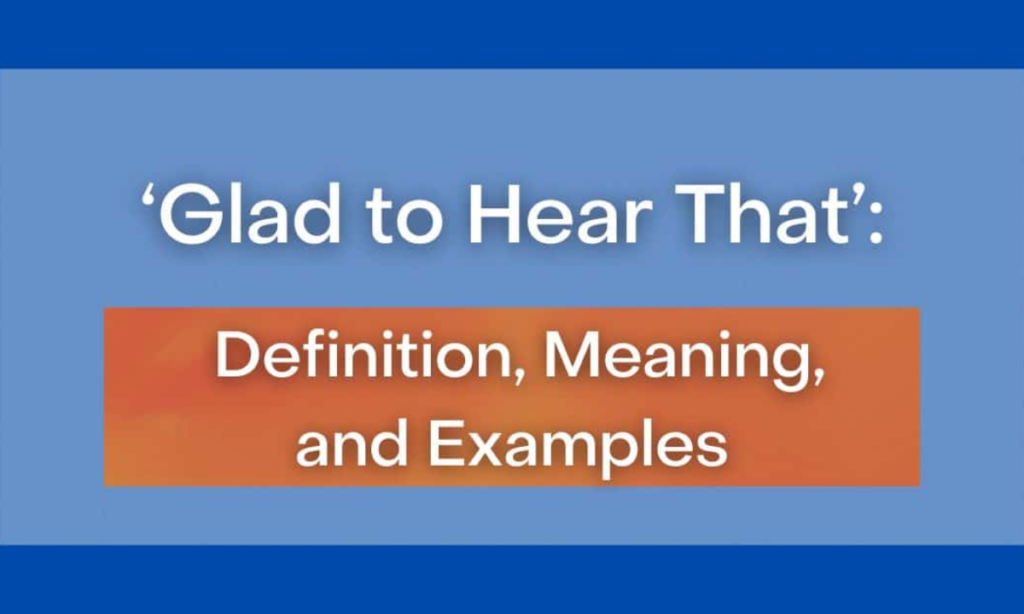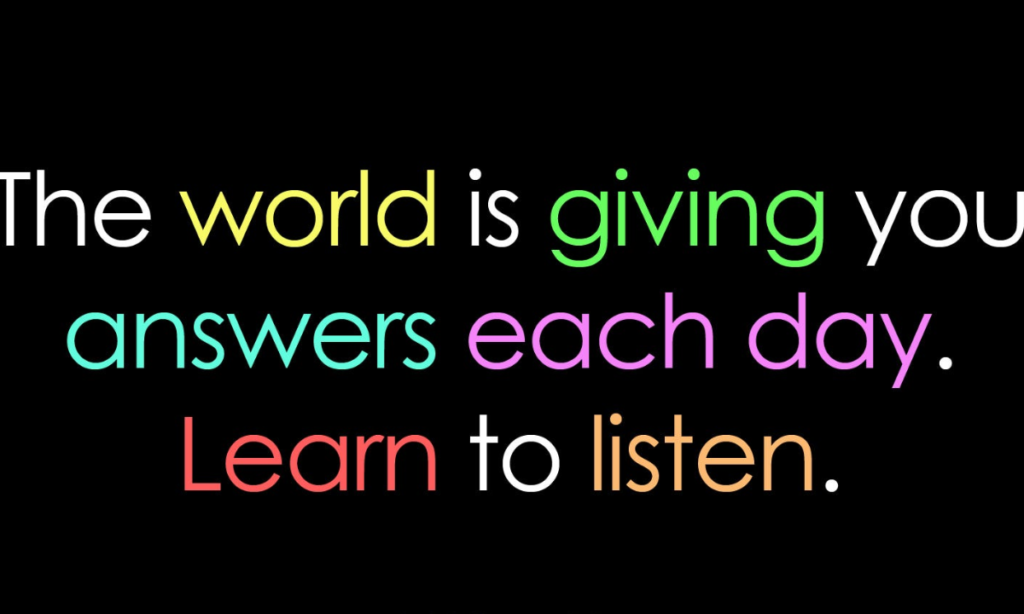“Beyond ‘Glad to Hear That’: Creative Ways to Share Your Happiness” explores various expressions to convey joy and support. It encourages using alternative phrases that resonate more personally with the listener. This approach helps strengthen relationships and fosters a positive atmosphere in conversations.
Are you tired of the same old responses when someone shares good news? Discovering new ways to express joy can make your conversations more engaging and heartfelt. Let’s explore creative alternatives to “Glad to hear that!” that will brighten someone’s day!
“Beyond ‘Glad to Hear That’: Creative Ways to Share Your Happiness” encourages using varied phrases to express joy. It suggests alternatives like “That’s wonderful!” or “I’m really happy for you!” Tailoring your responses to fit the context can make them more meaningful. Overall, this approach helps strengthen relationships and spread positivity in conversations.
11 Other Ways to Say “Glad to Hear That”
When someone shares good news, it’s nice to respond warmly. Instead of saying “Glad to hear that,” you can use other phrases. For example, you might say, “That’s wonderful to hear!” or “I’m so happy for you!” These options add variety to your conversations.
Using different expressions can make your responses feel more genuine. You can also say, “That’s great news!” or “I’m thrilled to hear that!” These phrases help convey your excitement. They show that you truly care about the person’s happiness.
Main Points
Alternative Expressions: Introduces a variety of phrases to replace “Glad to hear that,” offering both formal and informal options to convey joy.
Contextual Tailoring: Emphasises the importance of adjusting your responses based on the context, whether in professional or casual conversations.
Personal Touch: Encourages adding a personal touch to your replies to make them more heartfelt and genuine.
Positive Language: Highlights the use of enthusiastic and positive language to uplift others and create a joyful atmosphere.
Diversifying Communication: Advocates for a rich vocabulary to enhance communication, making interactions more engaging and memorable.
Formal Alternatives

When communicating in a formal setting, using polite phrases is important. Instead of saying “Glad to hear that,” you can say, “I’m pleased to learn this.” Another option is, “It’s reassuring to hear such good news.” These alternatives are suitable for professional environments.
In addition, you can express your happiness more formally. Phrases like “I appreciate you sharing this news” or “It’s delightful to receive this update” work well. Using these formal alternatives shows respect and professionalism in your communication.
Informal Expressions
Informal expressions are great for casual conversations with friends. They help create a relaxed and friendly atmosphere. Instead of saying “Glad to hear that,” you might say, “That’s awesome!” or “I’m so happy for you!”
Using informal phrases makes your response feel more personal. You can also say, “No way, that’s amazing!” or “That’s fantastic news!” These expressions show your excitement and strengthen your bond with others.
Polite Acknowledgments
Polite acknowledgments are important in maintaining respectful communication. They show that you value what someone has shared with you. Instead of saying “Glad to hear that,” consider saying, “Thank you for sharing this news.”
You can also express your happiness by saying, “I appreciate your update.” Another option is, “It’s nice to hear that everything is going well.” These polite phrases help create a positive atmosphere in conversations and strengthen relationships.
Positive Responses

Positive responses play a vital role in effective communication. They encourage openness and create a friendly atmosphere. Instead of saying “Glad to hear that,” try phrases like “That’s wonderful news!” or “I’m so happy to hear this!”
Using upbeat expressions can lift someone’s spirits. You can also say, “I’m thrilled for you!” or “That’s amazing!” These positive responses show your support and enthusiasm, helping to strengthen your connections with others.
Suitable Business Phrases
Using suitable business phrases is essential for effective workplace communication. In professional settings, it’s important to convey your thoughts clearly and respectfully. Instead of saying “Glad to hear that,” you might say, “I’m pleased to receive this information.”
Another great option is to use “Thank you for sharing this update.” Phrases like “That’s excellent to hear” also work well in business contexts. These suitable business phrases help maintain professionalism and foster positive relationships among colleagues.
You must watch Alternative Ways to Say ‘We Need to Talk
Less Emotive Options
Sometimes, less emotive options are better for formal situations. They provide a neutral response without overwhelming feelings. Instead of saying “Glad to hear that,” you might say, “That’s good to know.”
These phrases are suitable for professional or serious conversations. You can also use “I appreciate the update” or “Thank you for informing me.” Less emotive options maintain a polite tone while still acknowledging the good news.
Expressing Joy

Expressing joy is important in building strong relationships. Sharing your happiness can uplift both you and others. Instead of saying “Glad to hear that,” try using phrases like “That’s fantastic!” or “I’m so excited for you!”
Using joyful expressions can brighten someone’s day. You might say, “What wonderful news!” or “I’m really happy to hear this!” These joyful phrases help create a positive atmosphere and encourage open communication.
Close Connection Phrases
Close connection phrases help strengthen relationships with friends and family. Using these expressions shows that you care about their feelings. Instead of saying “Glad to hear that,” try saying, “I’m really happy for you!” or “That’s so exciting!”
These phrases create warmth and intimacy in your conversations. You can also use “I knew you could do it!” or “I’m thrilled to hear your news!” By using close connection phrases, you deepen your bond and make others feel valued and supported.
Email-friendly Alternatives
Using email-friendly alternatives can improve your written communication. In professional emails, it’s important to sound polite and positive. Instead of saying “Glad to hear that,” you might write, “I’m pleased to receive this update.”
Other phrases like “Thank you for sharing this information” also work well. You can use “It’s great to hear from you” to create a friendly tone. These email-friendly alternatives make your messages more engaging and professional.You must like Alternative Ways to Say Family Emergency
Diversifying Language
Diversifying your language is crucial for effective communication. Using a variety of phrases keeps conversations interesting and engaging. Instead of repeating “Glad to hear that,” you can say, “That’s fantastic!” or “I’m so excited for you!”
Having a rich vocabulary also helps express your feelings better. It allows you to connect with others on a deeper level. When you diversify your language, you make interactions more memorable and enjoyable for everyone involved.
Formal Vs. Informal Usage
Understanding the difference between formal and informal usage is essential. Formal expressions are suitable for professional settings and serious conversations. Phrases like “I’m pleased to hear that” convey respect and professionalism.
In contrast, informal expressions are perfect for casual chats with friends. They create a relaxed vibe and show closeness. Saying something like “That’s awesome!” makes the conversation feel friendly and approachable. Knowing when to use each style enhances your communication skills.
Exploring Alternatives: A Rich Vocabulary of Joy
Exploring alternatives to common phrases can enrich your communication. A rich vocabulary of joy offers many ways to express happiness. Instead of saying “Glad to hear that,” consider using phrases like “That’s so uplifting!” or “I’m delighted to hear this!”
Using varied expressions keeps conversations lively and engaging. You can also say, “That’s wonderful news!” or “I’m thrilled to know that!” These joyful alternatives add warmth and enthusiasm, making your responses more memorable and meaningful.
Expressing Enthusiasm: Phrases that Shine
Expressing enthusiasm can greatly enhance your conversations. Using vibrant phrases shows your excitement for others. Instead of saying “Glad to hear that,” try saying, “That’s absolutely amazing!” This small change can make a big difference.
Enthusiastic responses can inspire and uplift those around you. Phrases like “I’m overjoyed for you!” or “What fantastic news!” radiate positivity. By sharing your enthusiasm, you create a joyful atmosphere that encourages more open communication.
Personal Touch: Tailoring Your Response to the Situation
Adding a personal touch to your responses makes them more meaningful. Tailoring your reply shows that you truly care about the person’s feelings. For example, if someone shares exciting news, you might say, “I’m genuinely thrilled for you!”
It’s important to consider the situation when choosing your words. Using phrases like “That’s incredible news!” or “I knew you could do it!” makes your response more heartfelt. This connection enhances your conversations and strengthens your relationships.
Spreading Positivity: Using Happy Expressions in Conversations
Spreading positivity is essential in our daily conversations. Using happy expressions can brighten someone’s day. Phrases like “That’s fantastic!” or “I’m so excited for you!” help convey joy and support.
Incorporating these expressions creates a cheerful atmosphere. When we share our happiness, it encourages others to do the same. This exchange of positive feelings strengthens our connections and fosters a supportive environment.
Related posts:
When exploring different ways to express happiness, you might find related posts helpful. Topics like “Creative Responses to Good News” can offer fresh ideas. Other posts, such as “Positive Phrases for Any Occasion,” can enhance your communication skills.
Additionally, reading about “Synonyms for Expressing Joy” can expand your vocabulary. You can discover new expressions that fit various situations. These related posts will help you connect better with others and share your happiness more effectively.
Frequently Asked Questions
What are some alternative phrases to “Glad to hear that”?
You can use phrases like “That’s fantastic!” or “I’m thrilled for you!” to express joy more creatively.
How can I tailor my responses based on context?
Adjust your language by using formal expressions in professional settings and informal ones among friends to fit the situation.
Why is it important to add a personal touch?
A personal touch makes your responses feel more genuine and heartfelt, strengthening your connection with others.
What role does positive language play in communication?
Using positive language helps uplift the mood of the conversation and encourages a supportive environment.
How can diversifying my vocabulary benefit my interactions?
A rich vocabulary keeps conversations engaging and allows you to express your feelings more effectively, enhancing your relationships.
Conclusion
In conclusion, exploring creative ways to share your happiness can enhance your interactions. Using alternative expressions not only adds variety to your conversations but also makes them more engaging. Tailoring your responses based on context helps you connect better with others. By incorporating positive language and a personal touch, you can create a warm atmosphere. Overall, diversifying your vocabulary will strengthen your relationships and spread joy effectively.
For more details visit phrase pioneers

Tina Morris is an experienced blogger and a passionate wordsmith at Phrase Pioneers. With a keen eye for language and a deep love for writing, she shares insightful posts on grammar, phrases, and the art of communication.







